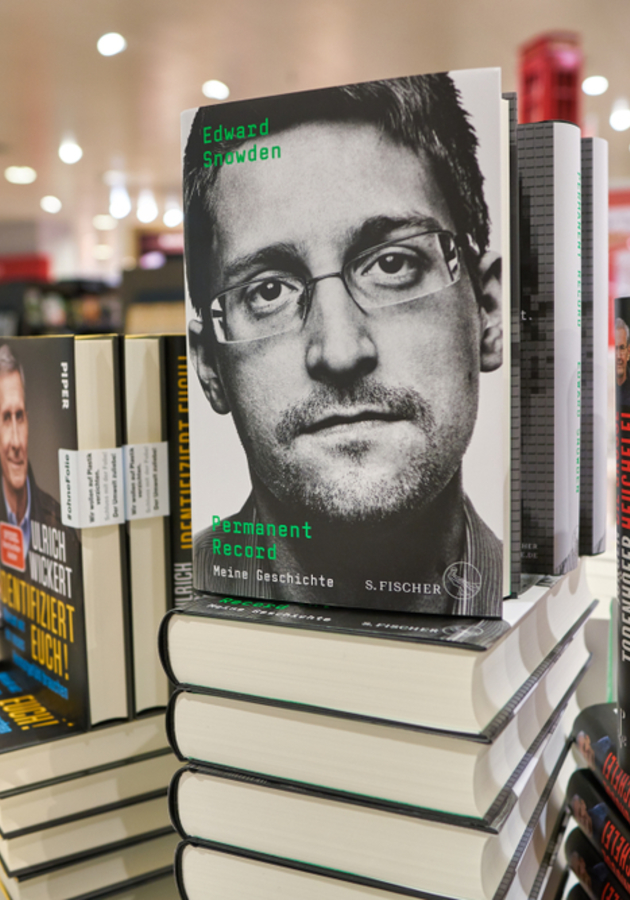“My name is Edward Joseph Snowden. I used to work for the government, but now I work for the public. It took me nearly three decades to recognize that there was a distinction.” That’s how “Permanent Record” begins, the long-awaited 2019 autobiography of, arguably, the most influential whistleblower of recent history. Get ready to learn more about him, his background and his motivations for the leaking of highly classified documents from the National Security Agency in 2013 – an event that revealed global surveillance programs and launched a thousand debates about authoritarianism, democracy, and privacy!
Clocks and cinder blocks
On June 21, 1989, Edward Snowden covertly reset all the clocks in his house by several hours. He had rebelled many nights before about having to go to bed even when not tired enough to fall asleep, but this time he was determined to do something about it. When his parents failed to notice, he felt overwhelmed with power and a sense of freedom, and began “galloping laps around the living room.” Soon after sunset, however, he fell asleep on the floor from exhaustion. When he awoke, the clocks in the house once again matched his father’s watch. Snowden’s mindset, though, had changed. In many ways, June 21, 1989, was the day he became what he will forever be known as: a hacker.
Snowden was born six years before this event, to the day. He grew up in a grand old redbrick house, raised by a patriotic family of public servants in Elizabeth City, North California. His father was a chief warrant officer in the Aeronautical Engineering Division at Coast Guard Headquarters, whereas his mother was a clerk at an independent insurance and benefits association that serviced employees of the NSA. When Edward was 9 years old, his mother started a new administrative job, so the family moved to Fort Meade, a United States Army installation in Maryland, incidentally built atop land once owned by some of Snowden’s ancestors.
Being an engineer in a government department at the very dawn of digitization, Edward’s father often came home from work with one interesting gadget or another: a Casio stopwatch, a single speaker for a stereo system, a cutting-edge scientific calculator. One day, with Edward watching from behind the curtain in his room, he brought “a mysterious box, close in size to a shoe box, and he removed from it a beige object that looked like a cinder block, from which long black cables snaked like the tentacles of some deep-sea monster.” Edward was amazed to notice that, after plugging one cable into the back of the TV and another into a wall outlet, his father was able to control what was happening on the screen. “I had come face-to-face with a Commodore 64,” he remembers, “one of the first home computer systems on the market.”
A sanctuary called the internet
Soon after the Snowdens moved to Maryland, Edward’s father brought home the family’s first desktop computer, a Compaq Presario 425, purchased at a military discount. The Compaq became Edward’s “constant companion, [his] second sibling and first love.” The relationship between the two deepened even further when, sometime later, his father brought home an expansion card and a modem. “Internet access and the emergence of the Web,” remarks Snowden, “was my generation’s big bang or Precambrian explosion. It irrevocably altered the course of my life, as it did the lives of everyone. From the age of twelve or so, I tried to spend my every waking moment online.”
And well, he pretty much did. Amazed at the amount of information suddenly available to him, Snowden developed “an insatiable desire to understand” everything he could on every imaginable subject. Between searching for god-mode cheat codes for “Doom” and “Quake” and watching “softcore-ish goth-y porn,” he gobbled up article upon article on everything from politics to martial arts to technology. A tutorial on how to fix a CD-ROM led to a crash course on how to build a computer which, in turn, led to a crash course in processor architecture. Before too long, Snowden became sort of an expert in electronic devices of all kinds.
However, the more he spent time online, the less he was interested in his school subjects. Already during his freshman year at Arundel High School, he stopped sleeping at night and began sleeping by day, in school, during the lessons. As a result, his grades began deteriorating, and soon enough, for unrelated reasons, so did the marriage of his parents. After their divorce, Snowden moved into his mother’s condo near Ellicott City. Around this time, however, he was diagnosed with infectious mononucleosis, as a result of which he had to miss four months of classes. When he was told that he would have to repeat his sophomore year, Snowden decided to drop out of Arundel High and enroll at Anne Arundel Community College, or AACC for short.
On the top of the world
Despite his bad grades, Snowden was already exceptionally smart as a teenager. When some of his teachers decided to have him IQ-tested as a way of diagnosing a suspected learning disability, the results arrived with words of admiration and some extra “enrichment assignments.” His teachers had discovered something the members of Snowden’s online communities already knew – that he was pretty much a genius. In fact, by the time he was asked to repeat his sophomore year by his high school, Snowden had already received an offer to work for the Los Alamos National Laboratory once he turned 18. This happened after he had casually discovered a security flaw on the website of America’s largest and most significant scientific research and weapons development institution. He was still in his early teens then.
He wasn’t much older when he got his first job. When he was 16, Snowden was hired by a 25-year-old married woman from his Japanese class at AACC to be a freelance Web designer at her budding online company. She paid him lavishly – $30 an hour – but as Snowden says, she could have paid him in smiles as well, and he would have still worked for her. Translation: this woman – whom he hides under the pseudonym Mae – was the first person he had ever fallen in love with. Six years later, as a 22-year-old, he would fall in love again, with a photography student named Lindsay Mills. The two met the way many people meet nowadays, but very few did back in 2005: online, at a now-defunct site called Hot or Not. Snowden and Mills are still together: they married in 2017, far from their home country, exiled by the United States government.
But we’re getting ahead of ourselves. At the time Snowden met his wife-to-be, he was a staunch patriot willing to die for his government. In May 2004, in the aftermath of the 9/11 attacks, he enlisted in the United States Army and was on track to become a Special Forces sergeant when he suffered bilateral tibial fractures. As a result, he was discharged from the army at the end of September the same year. Still wanting to serve his country, he applied for a high-level security clearance to work as a tech expert for an intelligence agency. After undergoing a stringent background investigation and passing a polygraph exam, Snowden eventually received the TS/SCI, the highest clearance in the United States. It was around this time that he met and fell in love with Lindsay Mills. He was 22 years old. He felt as if he was on the top of the world.
Homo contractus at the CIA
For a few months in 2005, Snowden worked as a night-shift security guard at the University of Maryland's Center for Advanced Study of Language, a research center sponsored by the National Security Agency (NSA). Afterward, he began attending government job fairs to find a better fit for his talents. As Snowden explains, “At the time, these events were held every month at the Ritz-Carlton in Tysons Corner, Virginia, just down the road from the CIA’s headquarters, or at one of the grubbier Marriott-type hotels near the NSA’s headquarters at Fort Meade.” At one of these fairs, Snowden got an offer to become a systems administrator at the CIA headquarters in Langley, Virginia, his first contracting job for the government.
Almost simultaneously, he became a member of class 6-06 of the BTTP, the Basic Telecommunications Training Program. Don’t let the name fool you: it is meant to intestinally obscure “one of the most classified and unusual curricula in existence.” That’s because the purpose of the BTTP is to produce highly skillful Technical Information Security Officers – or TISOs, for short – an elite cadre of CIA “communicators” whom Snowden describes as jacks-of-all trades. A TISO, he writes, is trained to be “a one-person replacement for previous generations’ specialized roles of code clerk, radioman, electrician, mechanic, physical and digital security adviser, and computer technician. The main job of this undercover officer is to manage the technical infrastructure for CIA operations, most commonly overseas at stations hidden inside American missions, consulates, and embassies.”
Soon after he completed the training in March 2007, the CIA sent Snowden with diplomatic cover to Geneva, Switzerland, and made him responsible for maintaining computer-network security. It was here that Snowden got his first glimpse into the clandestine operations of the agency. A few months after he moved to Geneva, something happened that left an indelible mark on his memory. It involved a CIA case officer specialized in human intelligence getting a Swiss banker drunk and pressuring him into driving home by himself instead of taking a cab. The banker eventually obliged, but soon after, the case officer called the Geneva police with the plate number of his car so he was arrested for driving under the influence.
Because in Switzerland fines are based on a percentage of income, the banker was slapped with an enormous fine, and he had his license suspended for three months. Feigning guilty conscience, the case officer offered to drive the banker back and forth between his home and work over the course of those three months, in an attempt to get some information out of him about Saudi Arabia’s suspected involvement in the global financing sector. When the ploy nevertheless failed, Snowden remembers that a fellow colleague remarked the following in a conversation with him: “Next time you meet someone, Ed, just give us his email address and we’ll take care of it.” Snowden nodded approvingly, without a clue of the full implications of the comment. Little did he know that he was about to learn – to his utter dismay.
Something’s rotten in the NSA
Snowden resigned from the CIA in February 2009 and shortly after took a job as a contractor for the NSA in Tokyo, Japan. His official job title was systems analyst, but much of his initial work was that of a systems administrator, as he was helping connect the NSA’s systems architecture with the CIA’s. Two things about the NSA stunned Snowden right off the bat: “how technologically sophisticated it was compared with the CIA, and how much less vigilant it was about security in its every iteration, from the compartmentalization of information to data encryption.”
Not long after he got the job, Snowden was asked to attend a conference in Hong Kong and give a presentation on China’s surveillance capabilities. Since he was asked at the last moment, Snowden stayed up all night reading up on the technology China used to monitor its citizens. He was shocked to learn how much data China was able to constantly collect, store and analyze about virtually every one of its billion citizens. What shocked him even more was a casual thought that crossed his mind at one point during his investigation: if the United States had so much information about what the Chinese were doing, who was to say they weren't doing the same thing? “I had the sneaking sense,” remembers Snowden, “while I was looking through all this China material that I was looking at a mirror and seeing a reflection of America. What China was doing publicly to its own citizens, America might be – could be – doing secretly to the world.”
However, it was only months later, when the Unclassified Report on the President’s Surveillance Program (PSP) mistakenly appeared on his desktop, that Snowden realized his suspicions weren’t unfounded. The Report detailed a program called STELLARWIND which, as he learned, had been covertly collecting all kinds of data from innocent American citizens without their knowledge for several years. The paper referred to this practice with the euphemism “bulk collection,” but Snowden knew exactly what the program entailed: “mass surveillance” of the American people.
Snowden spent the next few months struggling with the realization that he had never really been working for the good guys. By 2011, he began expressing his concerns to his girlfriend. Around the same time, his anxiety and traumas transformed into dizziness and exhaustion and eventually culminated in an epileptic seizure. After a series of seizures, Snowden took a long-term disability leave from his job. In his mind, he was already wondering what he was supposed to do next – or, rather, what would a man in his place do if he was told to do “the right thing.”
In a heartbeat
In March 2012, after recovering his health, Snowden began working at the Tunnel, “an enormous Pearl Harbor–era airplane factory turned NSA facility located under a pineapple field in Kunia, on the island of Oahu, Hawaii.” He was once again working as a contractor for the NSA, but – just as before – he was officially an employee of American computer technology company Dell. The job was a step down for Snowden in both the financial and professional sense, but he didn’t mind one bit. On the contrary, he was happy to move to Hawaii to enjoy a more relaxed lifestyle and somewhat less stressful duties.
He used his newfound free time to actively browse the NSA’s readboards, which he describes as digital bulletin boards not unlike news blogs, with the sole difference that the “news” they convey is the product of classified intelligence activities. To browse more efficiently, Snowden developed a system called Heartbeat, a sort of “readboard of readboards, an individually tailored newsfeed aggregator, bringing each officer all the newest information pertinent to their work, all the documents they had to read to stay current.”
Highly comprehensive and useful, Heartbeat was allowed access not only into the NSA network, but also into the networks of the CIA, the FBI, and the Department of Defense’s top-secret Joint Worldwide Intelligence Communications System. Moreover, Heartbeat was run from a server Snowden alone was responsible for. The server was set up to store a copy of every document it sourced, allowing Snowden to “perform the kind of deep interagency searches that the heads of most agencies could only dream of.”
However, at the time, he was only using Heartbeat to learn everything he could about the NSA’s surveillance program. That all changed on Constitution Day 2012, when, merely as a joke, he left a printed copy of the U.S. Constitution on the desks of each of his colleagues. When he decided to reread the Constitution himself, Snowden realized that the NSA’s surveillance program went against it, breaching particularly the Fourth Amendment. Rather than ensuring people’s freedoms and personal privacy, the intelligence agencies were violating them with impunity. Someone had to do something about it. And that someone, Snowden decided, was to be none other than himself.
Cincinnatus, the Rubik’s Cube guy
Deciding to expose the NSA’s surveillance program was one thing, but finding the proper way to do it was completely another. Extraordinary claims require extraordinary evidence, Carl Sagan said once, and the extraordinary evidence proving Snowden’s claims was located on the computers of one of the most secure institutions in the entire world. Moreover, as explosive as it was, the evidence was also too technical to be understood by the layperson, so Snowden was scared at first that even if he somehow managed to go public with it, he would still be misunderstood by the general public.
For the same reason, he decided to avoid WikiLeaks, the whistleblower’s forum of choice at the time. Following a backlash after the publication of disclosures by U.S. Army private Chelsea Manning, WikiLeaks had decided to change its practice of redacting materials before publishing them in an attempt to share them with the public in a pristine and as-received form. “This switch to a policy of total transparency,” writes Snowden, “meant that publishing with WikiLeaks would not meet my needs. Effectually, it would have been the same for me as self-publishing, a route I’d already rejected as insufficient.”
There was another problem with self-publishing. As Snowden remarks, thousands of people post supposedly “classified secrets” to the internet daily, so merely collecting the most incriminating documents from the NSA servers via the Heartbeat program and posting them online was never going to work, as leaks about mass surveillance seem trivial when compared to purported disclosures concerning aliens and time-travel technologies. The last thing Snowden wanted was his “incredible revelations” to “get lumped in with the outlandish and lost among the crazy.”
Eventually, Snowden became convinced that the best way for his revelations to be presented to the public was through respected and independent publications. With this in mind, he began contacting writers he believed to be untainted, primarily messaging with journalist Glenn Greenwald and documentarian Laura Poitras. Unable to reveal his true name, he messaged them under a variety of identities: “Cincinnatus,” after a legendary farmer who became a Roman consul and then voluntarily relinquished his power; “Citizenfour,” the fourth dissident-employee in the NSA’s recent history; and “Verax,” Latin for “speaker of truth,” and a hat tip to Julian Assange’s online persona “Mendax,” meaning “speaker of lies.”
In the meantime, Snowden had already begun the process of transferring relevant documents from the Heartbeat server to outdated desktop computers lying around the office, all done under the guise of “compatibility testing.” He would then compress and encrypt the documents only so he could transfer them a second time – this time onto SD cards. To get the SD cards out of the building and through security, Snowden famously hid them under the tiles of a Rubik’s Cube. Nobody suspected anything since he was always working the cube as he walked down the halls of the Tunnel. In fact, most of the people working there knew him as the Rubik’s Cube guy. He was about to become the most famous guy in the world.
And the truth shall… grant you a temporary asylum
On March 15, 2013, Snowden left Dell and began working as an “infrastructure analyst” at the National Threat Operations Center (NTOC) in Honolulu. He had asked the NSA for this transfer in an attempt to find out more about a program called XKEYSCORE, which Snowden had witnessed being used by his colleagues when they wanted to find out information about their current and former lovers, a practice they referred to as LOVEINT, or “love intelligence.” The XKEYSCORE proved to be even more powerful than Snowden ever thought it might be: a name or an IP address was all the info one needed to get every bit of information for almost every American citizen with an internet connection.
While researching XKEYSCORE, Snowden was concurrently preparing to leave the United States for good. Regardless of all the precautions he took, he knew that it was only a matter of time before he would be identified and caught by the government, as there were only a few people with access to the documents he wanted to share with the public. Even worse than the finality of the decision was the fact that Snowden couldn’t share anything of his plan with his girlfriend for fear of getting her in trouble. The day after Lindsay went on a camping trip with her friends, Snowden took an emergency medical leave of absence from work and fled the United States for Hong Kong via Tokyo. It was May 20, 2013.
Snowden took four laptops with him: one for normal communications, one for secure communications, a decoy and an air-gapped laptop, that is a laptop with no network interfaces. On June 2, Greenwald and Poitras met Snowden at the Mira Hong Kong Hotel. Poitras’ award-winning documentary “Citizenfour” was filmed over the course of the following six days in the hotel room, during which Greenwald and his colleague Ewen MacAskill interviewed Snowden. On June 5, The Guardian published Greenwald’s first piece. Snowden’s identity was revealed four days later through a video interview published on The Guardian’s website. On June 14, the U.S. government officially charged Snowden with espionage and on June 21, 2013, precisely 24 years after he had reset all the clocks in his North California house, they formally requested his extradition.
With no country wanting to risk its relationship with the United States, Snowden was refused asylum by almost every government in the world. Eventually, accompanied by journalist Sarah Harrison of WikiLeaks, he left for Ecuador, the country which had once granted asylum to Julian Assange. Since they were unable to fly directly from Hong Kong – as they were permitted from entering the airspace of the United States and many of its allies – they planned to fly to Russia first, then to Cuba, then to Venezuela, and finally to Quito, Ecuador’s capital. However, by the time Snowden reached Moscow, the U.S. State Department had canceled his passport. After spending 40 nights sleeping at the Sheremetyevo airport, Snowden was finally granted a temporary asylum by the Russian government. As of 2021, he still lives in Moscow, dreaming of going back to the United States one day.
Final notes
Well-written and jaw-droppingly absorbing, “Permanent Record” is a memoir of exceptional power and importance. Despite being a book of nonfiction, it reads almost like a literary thriller, to quote a review published in The New York Times. As stated in the same review, Snowden’s book is also an eye-opening political tractate, as it “pushes the reader to reflect more seriously on what every American should be asking already.”
First published on Constitution Day 2019 – to wide acclaim and rave reviews – Snowden’s memoir raises enough questions and eyebrows to singlehandedly “serve as a robust defense against accusations that he is a traitor.” Who knows, maybe it has already done its job: a year after the book hit the shelves, a U.S. federal court ruled that the mass surveillance program exposed by Snowden was illegal, and even possibly unconstitutional – precisely what he was saying from the beginning.
12min tip
The Fourth Amendment clearly states that people have a right to be “secure in their persons, houses, papers, and effects, against unreasonable searches and seizures.” Never allow any government to violate this right. It’s yours.





























